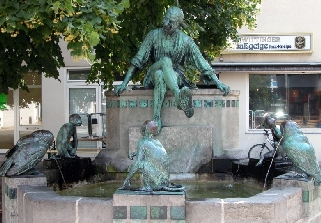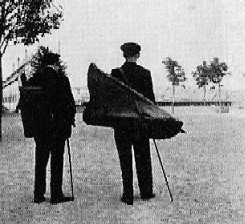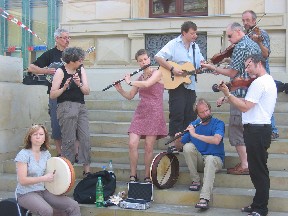 www.wilde-toene.de
www.wilde-toene.de
 www.wilde-toene.de
www.wilde-toene.de
|
Wild Sounds in Germany
Folk & The City: Braunschweig
Braunschweig is a city of 250,000 people in the state of Lower Saxony, located north of the Harz mountains at the farthest navigable point of the Oker river. The town's name is a combination of the name Bruno and wik, a place where merchants stored their goods. In the 12th century, Duke Henry the Lion made Braunschweig the capital of his state and it developed into an influentual trading centre, at times a thriving cultural centre as well.
The Burgplatz (castle square) in the town centre is comprising a group of medieval buildings: the Dom (cathedral, built at the end of the 12th century), and the Burg Dankwarderode (a 19th century reconstruction of Henry's old castle). In the square's centre stands the Burglöwe, a bronze statue of a lion, regarded as the oldest preserved large-scale sculpture north of the Alpes.
In World War II, Braunschweig was severely damaged by aerial attacks. Most of the
Altstadt (old town) and its half-timbered framework houses had been destroyed.
 A reminder of ancient Braunschweig, mostly re-built, are the Altstadtmarkt
(old town market), surrounded by the Gothic town hall and the Martinikirche
(church of St Martin), and the Magniviertel (St Magnus' Quarter), lined with
cobblestoned streets and little shops.
A reminder of ancient Braunschweig, mostly re-built, are the Altstadtmarkt
(old town market), surrounded by the Gothic town hall and the Martinikirche
(church of St Martin), and the Magniviertel (St Magnus' Quarter), lined with
cobblestoned streets and little shops.
Braunschweig is famous for Till Eulenspiegel, born in nearby Kneitlingen, a medieval jester who played many practical jokes on his fellow men. The Eulenspiegel fountain marks the place where Till baked owls and guenons instead of bread and scones.
In the 18th century, the town became the main residence of the rulers of the Duchy of Braunschweig-Wolfenbüttel. Their royal palace was demolished in 1960, its exterior was only recently rebuilt to contain a shopping mall. During their reign, Braunschweig - as the town of Wolfenbüttel before - became a cultural centre. Lessing's 'Emilia Galotti' and Goethe's 'Faust' were performed for the first time in Braunschweig. The 19th century Staatstheater (state theatre) dates back to the first standing public theatre in Germany, founded in 1690. The Herzog Anton Ulrich Museum from 1754 is, after the British Museum, the oldest public museum in the world.
Braunschweig had been the birth or work place of celebrities such as
scientist Carl Friedrich Gauß, poet Hoffmann von Fallersleben (author of the German
national anthem),
 writers Wilhelm Raabe, Friedrich Gerstäcker, Ricarda Huch, and composer Louis Spohr.
It is also the head office of the piano manufacturers
Wilhelm Schimmel and Grotrian-Steinweg.
writers Wilhelm Raabe, Friedrich Gerstäcker, Ricarda Huch, and composer Louis Spohr.
It is also the head office of the piano manufacturers
Wilhelm Schimmel and Grotrian-Steinweg.
The town of Salzgitter in the south had been a worldwide renowned musician's point of origin in the 19th century. The rather small town probably outshines any other places. More than 5,000 of its citizens - calling themselves klesmer, but are not to be confused with Yiddish musicians - performed worldwide from about 1790 to 1900 - at the court of the Russian Czar as well as in the Australian outback.
In 1968 the folk revival came to Braunschweig. After a concert of singer/songwriter Franz-Josef Degenhardt at the Technical University, the time was ripe for regular presentations of international folk music, chansons, ballads and topical songs. The folk club FOLK 69 was established in the following year, which soon found its home in the legendary Freizeit- und Bildungszentrum (FBZ) Bürgerpark. A folk festival followed in 1972.
The legendary Folk Meetings and Folk 69 were a myth long gone, when another generation of folkies together with some veterans tried to establish a folk music scene by the Oker river again. In 1997 the first Klesmerfestival in Salzgitter commemorated its musical heritage.


Photo Credits:
(1) Wilde Töne festival logo
(by Wilde Töne festival);
(2) Dom & Burglöwe,
(3) Till Eulenspiegel fountain
(by Wikipedia);
(5) Round the Table Irish folk session band,
(6) Hotel Palindrone @ Wilde Töne 2008,
Braunschweig-born Albin Paulus leading the dance (by Walkin' Tom);
(4) Klesmer musicians Ferdinand Flecks & August Söchting (unknown).
|
To the German FolkWorld |
© The Mollis - Editors of FolkWorld; Published 03/2009
All material published in FolkWorld is © The Author via FolkWorld. Storage for private use is allowed and welcome. Reviews and extracts of up to 200 words may be freely quoted and reproduced, if source and author are acknowledged. For any other reproduction please ask the Editors for permission. Although any external links from FolkWorld are chosen with greatest care, FolkWorld and its editors do not take any responsibility for the content of the linked external websites.
